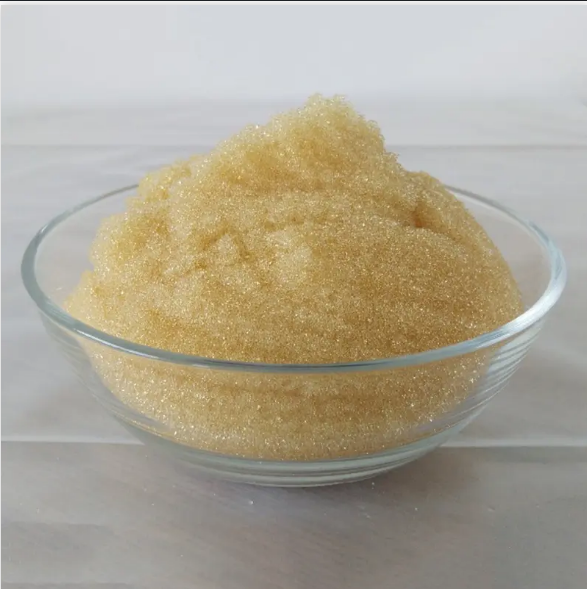



| Item | Index | |
|---|---|---|
| Polymer Matrix Structure | Styrene - DVB | |
| Functional Group | R—(SO3)-M+ | |
| Ionic Form | Na | |
| Moisture Content % | 42.00 ~ 50.00 | |
| Capacity in Weight mmol/g | ≥ 4.40 | |
| Capacity in Volume mmol/ml | ≥ 2.00 | |
| Shipping Weight g/ml | 0.78 ~ 0.88 | |
| True Density g/ml | 1.250 ~ 1.290 | |
| Particle Size | 315~1250(Size Range μm) | |
| ≤ 5.00(>1250μm %) | ||
| ≤ 0.50(<315μm %) | ||
| Uniformity Coefficient | ≤ 1.60 | |
| Whole Spherical % | ≥ 90.00 | |
| Whole Spherical Rate After milling % | ≥ 70.00 | |
| Packing | in 25kg bags |
|---|---|
| Storage | 20°C,2 years |
| Shipping | Room temperature in China;may vary elsewhere |
Tel: 0086 25 52397805
Email: info@nj-finechem.com

| Common Names | Wang resin | ||
|---|---|---|---|
| Structure |  |
||
| CAS No. | 201058-08-4 | Boiling Point (℃) | 386.2ºC at 760 mmHg |
| Molecular Weight | 228.286 | Melting Point (℃) | N/A |
| Appearance | Off-white to beige beads | Vapor Specific Gravity | - |
| HS Code | 3909400000 | Flash Point (℃) | 175.2ºC |
| Solubility | - | Autoignition Temperature (℃) | - |
| Safety Phrases | 26-36/37/39-24/25 | ||
|---|---|---|---|
| RIDADR | 2211 | ||
| WGK Germany | 3 | ||
| Packaging Group | III | ||
| Hazard Class | - | ||
| SYMPTOMS | PREVENTION | FIRST AID | |
| Inhalation | poisonous | wear a mask | fresh air,keep breath comfortable |
| Skin | skin burn | wear protective clothing | Remove all soiled clothing and wash your skin with water. |
| Eyes | eye injury | wear goggles | Rinse slowly and gently with water for a few minutes |
| Ingestion | poisonous | Do not eat, drink or smoke while using this product | Call a POISON CENTRE or doctor |

What is ZGC 108DQ Gel Type Cation Resin FOOD GRADE?
Resin is a type of resin that refers to the cationic ion exchanged in the ion exchange separation method. It is widely used in the fields of water treatment, medicine, chemical industry, etc. ion exchange process is a reversible chemical reaction between ions in the liquid phase and ions in the solid phase, when some ions in the liquid phase are preferred by the ion exchange solids, they will be adsorbed by the ion exchange solids, and in order to maintain the electroneutrality of the aqueous solution, the ion exchange solids have to release equivalent ions back to the solution. In order to maintain the electrical neutrality of the aqueous solution, the ion exchange solid must release equivalent ions back into the solution.
How is ZGC 108DQ Gel Type Cation Resin FOOD GRADE stored and distributed?
1, the ion exchange resin contains some water, should not be stored in the open air, the storage and
transportation process should be kept wet, so as not to wind drying and dehydration, so that the
resin is broken, such as storage process of the resin dehydration, should be soaked in concentrated
saline (10%), and then gradually diluted, shall not be put directly into the water, so as not to
avoid the resin to expand sharply and broken.
2, winter storage and transportation use, should be kept in the temperature environment of 5-40 ℃,
to avoid overcooling or overheating, affecting the quality, if there is no heat preservation
equipment in winter, you can store the resin in brine, the concentration of brine can be determined
according to the air temperature.
What is ZGC 108DQ Gel Type Cation Resin FOOD GRADE used for?
1. Water treatment: Used to remove calcium, magnesium and other hardness ions in water solution,
which will form lime scale in water, thus damaging pipes and equipment. In order to prevent the
formation of lime scale, these ions can be removed by cationic resin. 2.
2. In industrial processes: There are purification and separation roles in industry, where specific
ions can be selectively adsorbed from a mixed solution and released in subsequent steps. This is
important for the purification of pharmaceuticals, the extraction of useful components and the
removal of hazardous substances. 3. Enrichment and purification, mainly used in metallurgy,
wastewater extraction substances, pharmaceutical/fine chemical intermediates purification and
refining
3. In the laboratory: it can be used to prepare high purity solutions, remove impurity ions and
adjust pH. Meanwhile, it is also used in chromatography analysis, protein purification and nucleic
acid extraction.
4. Catalyst, used to catalyze chemical reactions, with strong acidic resin applications mostly.
In short, cation exchange resin plays an important role in water treatment, industrial processes and
laboratories. Its unique structure and function make it an effective material for removing ions from
solution and enhancing the purity and quality of water and chemicals.